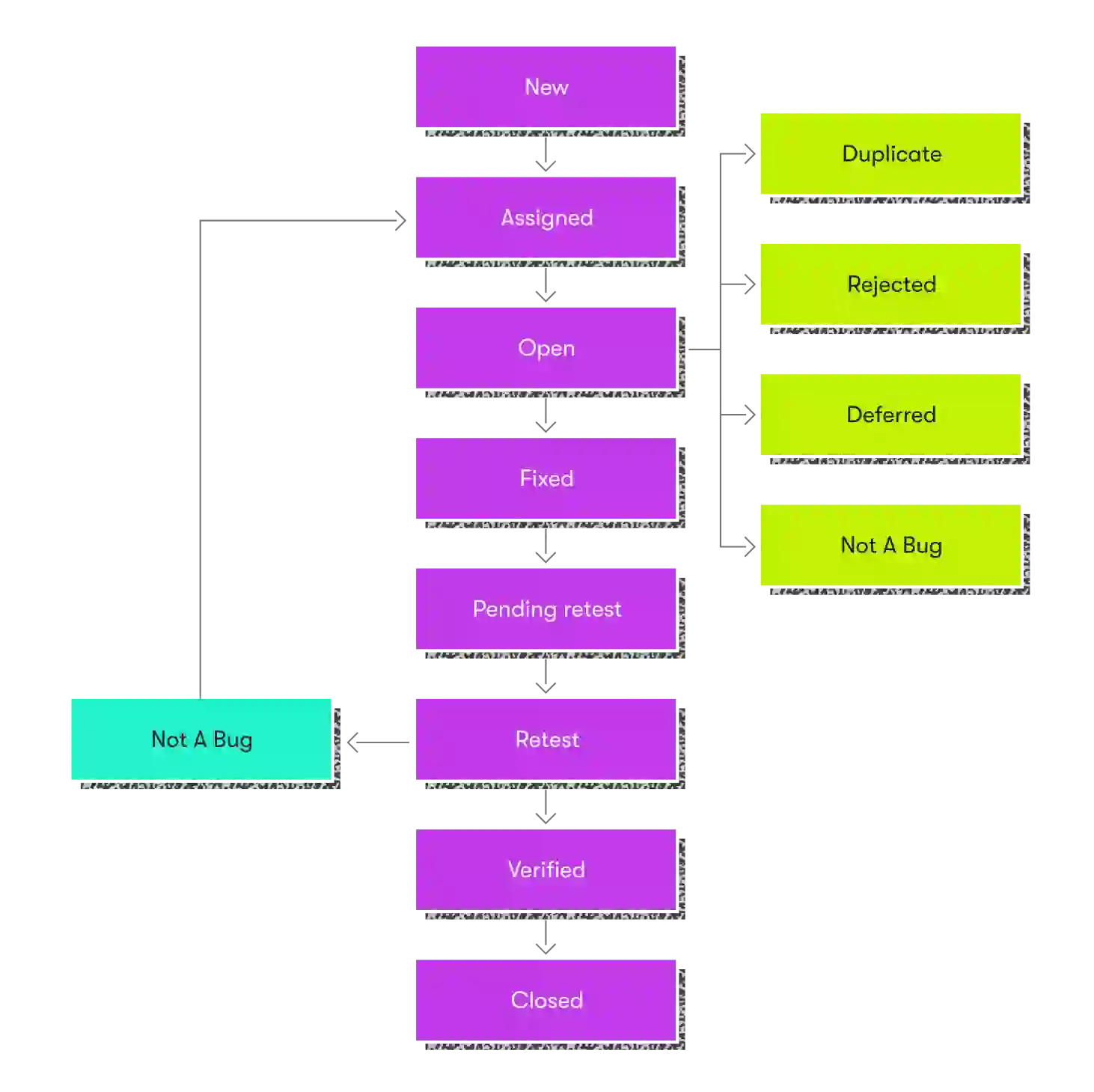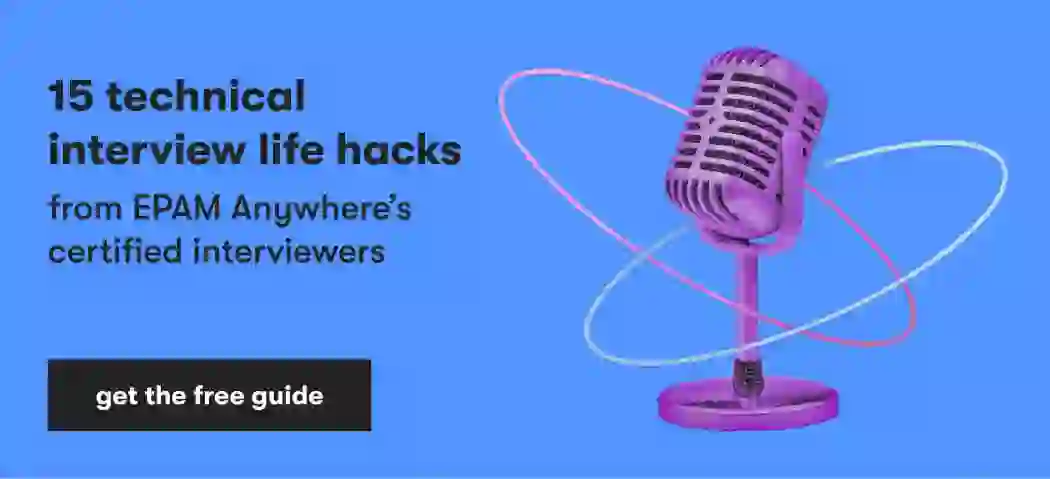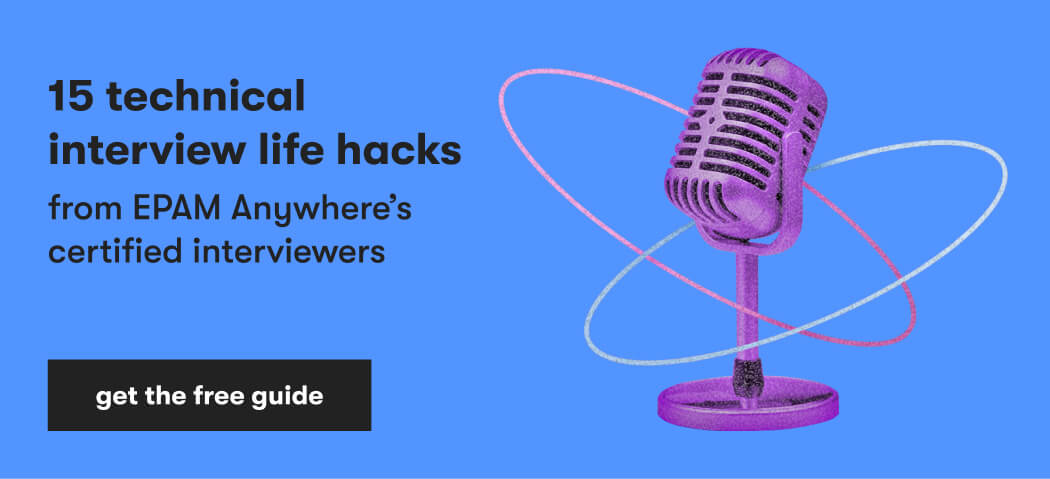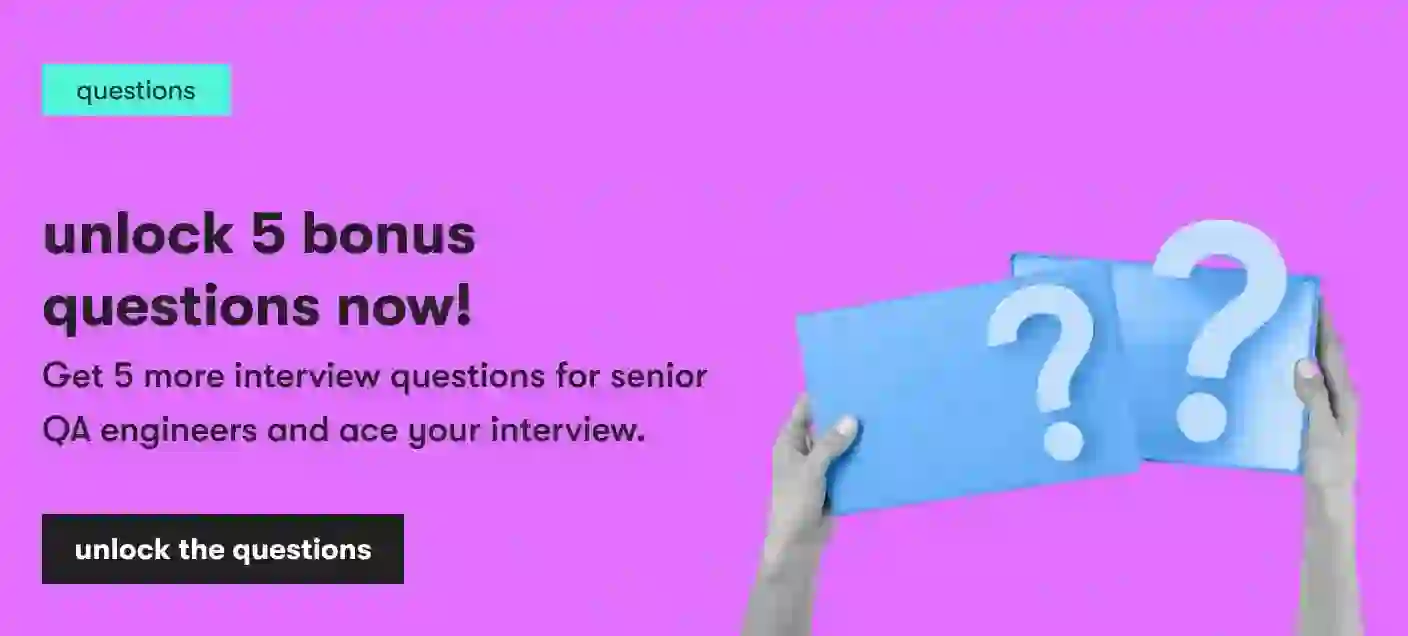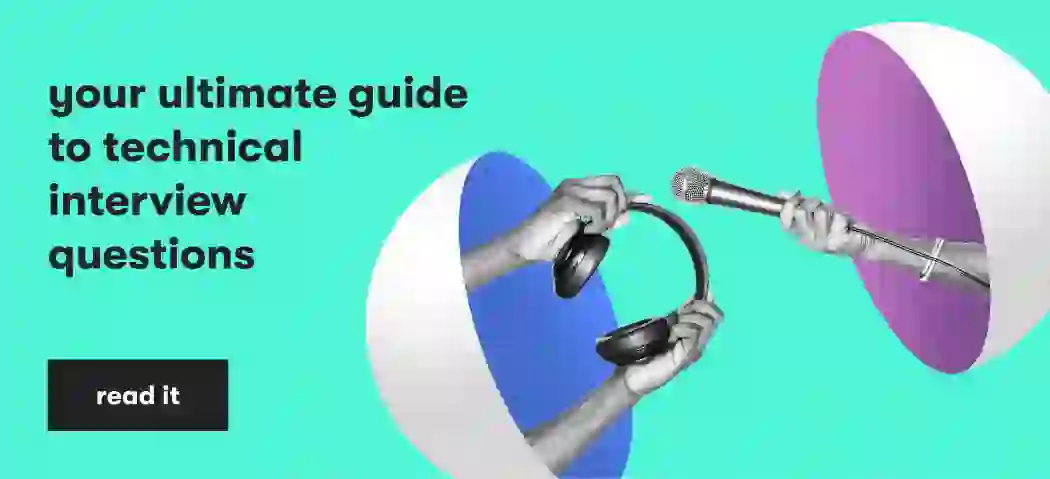To help you ace your interview, we have compiled ten common functional testing interview questions in cooperation with EPAM Anywhere’s senior and lead software testing engineers. They’ve been there themselves!
Let’s answer each interview query in detail, that way you are prepared to respond appropriately and land your functional QA engineer job.
Before we jump into the common interview questions for functional testing, it is a good idea to quickly mention the standard hiring expectations. You certainly need to display your technical skills, but don’t forget the basics: read and review the job description, research the company and its current direction, and practice a personal introduction.
By covering these oft-forgotten requirements, you can avoid possible embarrassment. Start the interview on the right foot. If possible, take part in mock interviews with colleagues and, of course, always dress the part. With a good impression established, you can dive into the testing
“Once the interviewer introduced himself and shared the agenda, I got a chance to tell more about my experience in functional testing. That’s the best part, where you can highlight all your strengths, so if you haven't thought about it yet, I suggest you prepare the part in advance, so you appear in the most favorable light.”

While pre-interview preparation is crucial, the real action occurs with the skills assessment. The functional tester interview questions are a chance to showcase your problem-solving and analytical skills, so be sure to practice and prepare accordingly.
If you come across terms or definitions that you do not fully understand, it is a good idea to engage in some extended research in advance. You can use the following questions as a launch pad into specific areas or skill sets in which you currently underperform.
Beyond the technical answers themselves, use each functional tester interview question to explain your personal approach to the craft and understanding of QA best practices. Soft skills such as leadership, collaboration, and creative thinking score bonus points, so consider each question a chance to demonstrate your unique work ethic.
Now, you are ready to check out the top 10 common functional testing interview questions:
1. What is the difference between verification and validation?
Verification and validation both refer to process evaluations, but at different points of the development phase. Verification focuses on pre-development, ensuring that the end product meets the specified functionality requirements (in other words, that you are building the right app). Validation focuses on post-development, where you ensure that the final application meets the demands of the customer.
There are a couple other differences you should also note, since this is an open-ended question. Verification involves activities such as inspections, reviews, and walkthroughs, while validation employs system testing, integration, and user acceptance. Verification and validation occur in sequential order, but only code execution occurs during the validation stage. The testing types that are used also go by different names (verification is also known as static testing, while validation is considered dynamic testing).
“What distinguished EPAM Anywhere from other companies that interviewed me was the ‘no-pressure’ atmosphere, which is not always present during interviews. The interview progressed almost like a dialog between two acquaintances discussing functional testing topics, even though, of course, I hadn’t met the interviewer before. So the experience itself was really pleasant, and I liked the company immediately since I understood that I had just experienced a part of the company's culture and it was very welcoming.”

2. What is the difference between a test plan and a test strategy?
Another interview question about QA fundamentals, this question offers you a chance to not only note the differences between a test plan and test strategy, but also show how they are related. The more detail you can provide, the better — and, if possible, give real-world examples to explain your understanding of the two terms (since they are often confused).
Make sure you note that a test plan is a project-level document that defines how testing will be done and who will test. It lists the objectives of all testing, with unique features like pass-or-fail criteria. On the other hand, a testing strategy is an organization-level document explaining test design and the techniques used to reach any testing goals. Test strategy is a long-term vision that outlines testing team structures.
3. What is the difference between severity and priority?
Severity and priority both concern how a bug is addressed. Severity measures the degree of impact on the function of a system, while priority defines the business importance and the timeframe placed on bug resolution. Think of priority as how soon the bug needs to be fixed according to company and customer needs, while severity refers more to the actual application operation.
As a tester, it is your job to define and determine the status of any bug, so be sure to explain your process, as well as common status names.
- Severity: Critical, Major, Minor, Low
- Priority: High, Medium, Low
Additionally, note how you would use the term in a real-world situation and how you would achieve balance when different stakeholders assign different weights to severity and priority.
4. What is a defect life cycle?
A defect is any error in an application that disrupts the normal flow of operation. It is your job as a functional tester to locate and eliminate as many bugs as possible before they reach the customer.
Each defect has a life cycle that determines its current state. The interviewer wants you to explain this life cycle in detail; that way, they can assess your tester skill sets and overall approach to addressing bugs. Use examples from previous projects if you can.
Defect life cycle states
- New: Any recently located bugs are given a “new” status
- Assigned: The new defect is assigned to a development team for correction
- Open: Analysis and corrective actions begin
- Fixed: All changes to the defect are completed
- Pending Retest: The developer reassigns the defect back to the tester
- Retest: the tester verifies the fixed defect
- Verified Closed: With no additional flaws, the test cycle is verified and closed

“It’s always a good idea to review your theoretical knowledge of functional testing fundamentals. This is essential to a successful interview. Don’t ignore aspects such as different test design techniques or details of methodologies, for example, the difference between Definitions of Done and Definitions of Ready in Scrum.”

5. How will you tackle a situation where a defect is reported in production?
For situation-based queries typical for senior QA engineer interview questions, make sure you give plenty of detail. Do not generalize. Since every project process operates under a different testing strategy, there are no one-size-fits-all answers. The purpose of such an interview question is to discover your problem-solving skills, attention to detail, and experience level. Rote responses or rapid solutions that do not explain your process within the hypothetical will show a lack of understanding regarding the unique nature of each defect cycle.
When answering, you can rely on common functional testing methods. It never hurts to mention priority and severity status, checking to see if a hotfix deployment is necessary, reproducing the defect in lower environments, and adding the missed scenario in the regression suite to limit issues in future releases.
“There were some situations that I hadn’t encountered so far, so the interviewer asked me to imagine such a situation and propose a possible solution. In such cases, the main goal is to check the way you think, so I suggest that you think out loud, and explain why you decided to choose that exact solution. It's not a good idea to just say the final decision you came up with. Doing so won't work in your favor as much as the elaborated answer.”

6. What are entry and exit criteria?
The entry and exit criteria refer to the reasoning for a test and its expected results. Software testing audits do not occur in a vacuum, so they need a series of parameter activities to carry out a specific methodology for certification.
Plus, any testing life cycle follows a set of phases:
- Requirement analysis
- Test planning
- Test case development
- Test environment setup
- Test execution
- Test cycle closure
Before you can move on to the next phase in your system testing life cycle, each stage must meet the necessary entry and exit criteria.
Entry requirements are related to the company's test strategy and involve the availability to complete code, test cases, and test environment setups. Exit criteria focus on the closure of verified defects, completed test cases, and budget restrictions.
7. What is boundary value analysis and equivalence partitioning?
As a more advanced functional interview question, you are ultimately defining black box test design, a type of testing that does not look at the inner workings of the code, but only evaluates the inputs and outputs of the software system.
Differing testing techniques exist within that definition. A boundary value analysis focuses on the possible errors found within the extreme ends of any input domains. For equivalence partitioning, all input domain data are partitioned in set data classes that showcase similar behavior, a way to reduce the total amount of test cases required.
In the interview, you can give specific examples to demonstrate your tester skills. It is a good idea to do advance research on each functional testing technique since they are expansive subjects — the more detail you provide, the better.
8. What are the key elements when reporting a bug?
A software defect report conveys detailed information about the bug issues to the developers who will replicate and fix the error. The better you are at writing reports, the easier the defect life cycle will be for the entire team.
With this question, the interviewer wants to gain a sense of how you would write a report and, by extension, collaborate as a team lead. Make sure you illuminate the essential standard information involved:
- Unique ID
- Short description
- Steps to reproduce
- Environment
- Severity
- Priority
- Screenshots/logs
- Reporter name
- Assignee
9. What is the difference between bug release and bug leakage?
Bug release and bug leakage refer to known errors, but at different stages of consumer release.
Bug leakage: When a bug is missed by the testing team and found by a customer on the user end, that is considered bug leakage.
Bug Release: Certain application versions are released with a known set of low priority/severity bugs.
The interviewer asks this question because they want to learn your process for mitigating client-facing issues. Be sure to explain how you would address bug leakages, compare timely application delivery versus reaching testing perfection, client audits, and releasing applications with bugs that consumers are willing to tolerate.
“When I was interviewed for a lead position at EPAM Anywhere, I was asked a number of questions regarding processes and working with a team, coordination and organizing things, solving difficult situations, etc. For instance, I was asked to explain how I would handle an employee that constantly misses deadlines, what devices I would choose for testing, and how I would organize testing processes from scratch once I’m on a new project.”

10. What is the difference between smoke and sanity testing?
Smoke and Sanity are both testing processes that evaluate an application, but with different sets of considerations.
Smoke testing determines the stability of a software build. It is a shallow form of testing, meant to improve the overall value of the system with a limited number of test cases and detail. You can use automated solutions to reduce manual labor, depending on the generation of tools you use.
Sanity testing assesses if a software build functions as expected. It is a subset of regression testing and focuses on a narrow operation scope.
Bonus tips: interview dos and don’ts
While your preparation for the above questions will help you deliver eloquent and accurate responses in the interview, don’t forget these important dos and don’ts for hiring:
- DO be on time; at least 15 minutes early if possible
- DON’T insult previous employers
- DO make eye contact and face the interviewer
- DON’T answer your cell phone in the interview
- DO ask for clarification if you need it
- DON’T hide or shy away from aspects of your resume
It may sound obvious, but it’s important not to lie or exaggerate your achievements when talking about your experience. This can easily be checked with a few extra questions, leaving you no chance to succeed in the interview. Instead, it's always a good idea to say that you haven't worked with something yet but you would love to have the opportunity in the future, or share theoretical knowledge you have on the topic if possible.

By following these tips, you can convey a sense of genuine interest in the company and its open position. The better the first impression you create, the better your chances of showing your true abilities and getting hired.
“My technical interviewer asked questions related to manual testing, API testing, and some SQL queries. I always tried to answer his questions by making reference to my previous project experience and trying to be genuine. I did not answer his questions theoretically, but in a more practical way by relating each question to my work. I believe this impressed the interviewer more, since it told him about my work experience in a better way. The second thing that I think worked was my confidence level, and my clarity about my answers. In the end, do not fake anything, be real and be yourself.”

While functional testing interview questions may present a challenge, with the right answers, you will be well on your way to building a promising career as a test analyst or engineer. If you're only considering applying for a job, see how you can optimize your CV in this manual tester resume example.
Special thanks to Olena Muzyka, Lead Software Testing Engineer and Certified Technical Interviewer, EPAM Anywhere, for her contributions to this article.

Explore our Editorial Policy to learn more about our standards for content creation.
read more





